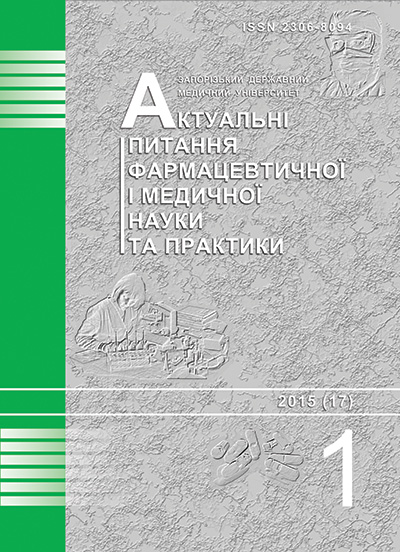THE STUDY OF HYPOGLYCEMIC ACTIVITY OF 3-BENZYL-8-METHYLXANTHINE DERIVATIVES
DOI:
https://doi.org/10.14739/2409-2932.2015.1.41699Keywords:
Xanthines, Hyperglycemia, Hypoglycemic EffectAbstract
Diabetes mellitus is a chronic endocrine disease. It etiology is the impact of both endogenous (genetic) and exogenous factors that cause absolute or relative shortage of insulin or not effective use of it, which in turn leads to disruption of all kinds of substances exchange. The study of this problem is actual due to the high prevalence of diabetes, chronic disease, the tendency to increase the number of patients, their high morbidity and mortality. Diabetes is characterized by high blood glucose levels, which eventually leads to various complications associated with many human systems damage. Hormones (insulin and its analogues) and synthetic drugs (sulfonylureas, biguanides etc.) are used For the treatment of diabetes, but their high toxicity, cumulativeness, various side effects (autoimmunization, cutaneous allergic reactions, disturbance of the micro flora of the digestive tract), and the formation of insulin resistance restrict the use of these drugs in clinical practice. On this aspect the attention of researchers is attracted to xanthine derivatives, which are known as substances with wide range of biological activities including hypoglycemic.
Based on the above, the search and development of new drugs among new 3-R-substituted xanthine, which would have hypoglycemic effect and would be deprived of most side effects is an acute problem of modern medical and pharmaceutical sciences.
The aim of this study was to investigate the hypoglycemic activity of newly synthesized derivatives of 3-benzyl-8-methylxanthine and establish certain patterns "structure-activity" relationship.
Materials and methods
As objects of study for hypoglycemic activity we used derivatives of
3-benzyl-8-methylxanthine synthesized at the Department of Biochemistry and LaboratoryDiagnostics ofZaporizhzhyaStateMedicalUniversity.
Hypoglycemic action of xanthine derivatives evaluated by intraperitoneal glucose tolerance test, which was reproduced by injection to animals (white rats weighing 160-230 g) glucose at a dose of 2 g/kg. The experimental animals were divided in 14 groups of 7 animals in each:
1. Intact – animals administered saline;
2. Control – modeling hyperglycemia without treatment.
3-13. Animals were injected xanthine derivatives at the background of hyperglycemia modeling.
14. The animals were injected metformin at the background of hyperglycemia modeling.
We determined glucose level in blood using a glucometer «Accu Chek Active» after 30 and 60 minutes.
Research results processed by modern methods of analysis using Student t-test. We used the level of statistical significance of differences of research results - p<0.05.
Results and their discussion
Presence of methyl and benzyl group or acetate residue at position 7 of xanthine bicycle resulted in incresing of glycemia in the blood of experimental animals. Replacing carboxyl hydroxyl to propoxy group or adding naphtylmethyl substituent reduced glycemia (compound 8 and compound 3) after 30 min glucose injection.
Conclusions
As a result of the research it was found that most hypoglycemic activity among the compounds that were studied, has 3-benzyl-7-(2-naphtylmethyl)-8-metylxanthine. Obtained results can be used in further searching of potential biologically active substances with hypoglycemic properties among derivatives of 3-benzylxanhine.
References
Ametov, А. S., & Ovsyannikov, K. V (2000). Aktual'nye voprosy terapii saharnogo diabeta II tipa [Actual questions of therapy of II type diabetes mellitus]. Mezhdunarodnyj zhurnal medicinskoj praktiki, 12, 40–43. [in Russian].
Alekseeva, G. G., Yukhlova, N. A. (1979). Vliyanie α i β-adrenoblokatorov na uroven' glikemii, soderzhanie gormona rosta v krovi i e`kskreciyu kateholaminov s mochoj pri insulinozavisimom sakharnom diabete [Influence of α and β-adrenoblockers on the level of glycemia, content of growth hormone in blood and excretion of catecholamines with urea during при insulin-dependent diabetes mellitus]. Problemy e`ndokrinologii, 25(3), 13–18. [in Russian].
Demidova, I. Yu. (2002). Lechenie sakharnogo diabeta 2 tipa [Treatment of II type diabetes mellitus]. Pharmateka, (5), 3–8. [in Russian].
Zaliubovska, O. I., Litvinova, O. N., Zlenko, V. V., Fomina, G. P., & Karabut, L. V. (2013). Poshuk rechovyn z hipohlikemichnoiu aktyvnistiu sered novykh pokhidnykh oksaminovykh kyslot [Search of hypoglycemically active substances among new oxaminic acids derivatives]. Visnyk problem biolohii i medytsyny, 1(98), 101–103. [in Ukrainian].
Eckhardt, M., Himmelsbach, F., Langkopf, E., Maier, R., Mark, M., Davvon, M. (2004). Pat. WO 2004046148 A1, Int. Cl7 C07D 473/04, A61K 31/522. Novel xanthin derivatives, production and use thereof as medicaments. №WO2003EP12821 20031117; Pub. date 03.06.2004. 91 p.
Elgaher, W. A., Hayallah, A. M., Salem, O. I. A., & Alim, M. A. (2009). Synthesis, anti-bronchoconstrictive, and antibacterial activities of some new 8-substituted-1,3-dimethylxanthine derivatives. Bulletin of pharmaceutical science, 5, 153–187.
Kozhemiakin, Yu. M., Khromov, O. S., Filonenko, M. A., et al. (2002) Naukovo-praktychni rekomendatsii z utrymannia laboratornykh tvaryn ta roboty z nymy [Scientific and practical advice on the maintenance of laboratory animals and work with them]. Kyiv. [in Ukrainian].
Stefanov, O. V. (Ed.) (2001) Doklinichni doslidzhennia likarskykh zasobiv [Preclinical studies of drugs]. Kyiv: Avicena. [in Ukrainian].
Levich S. V., Shkoda O. S., Aleksandrova K. V. (2013). Syntez ta fizyko-khimichni vlastyvosti S-zamishchenykh pokhidnykh 3-benzyl-8-metyl-7-[(4-fenil-5-tio-4H-1,2,4-triazol-3-il)metyl]-ksantynu [Synthesis and physicochemical properties of S-substituted of 3-benzyl-8-methyl-7-[(4-phenyl-5-thio-4H-1,2,4-triazol-3-yl)methyl]xanthine]. Aktualni pytannia farmatsevtychnoi ta medychnoi nauky i praktyky, 1(11), 54–58. [in Ukrainian].
Prozorovskij, V. B. (1998). Tablichnyj ekspress-metod opredeleniya srednikh e`ffektivnykh mer vozdejstviya na biologicheskie ob``ekty [Table express-method of determinition of average effective measures of inluence on biological objects]. Toksikologicheskij vestnik, 1, 28–32. [in Russian].
Downloads
How to Cite
Issue
Section
License
Authors who publish with this journal agree to the following terms:
Authors retain copyright and grant the journal right of first publication with the work simultaneously licensed under a Creative Commons Attribution License that allows others to share the work with an acknowledgement of the work's authorship and initial publication in this journal. 
Authors are able to enter into separate, additional contractual arrangements for the non-exclusive distribution of the journal's published version of the work (e.g., post it to an institutional repository or publish it in a book), with an acknowledgement of its initial publication in this journal.
Authors are permitted and encouraged to post their work online (e.g., in institutional repositories or on their website) prior to and during the submission process, as it can lead to productive exchanges, as well as earlier and greater citation of published work (See The Effect of Open Access)

